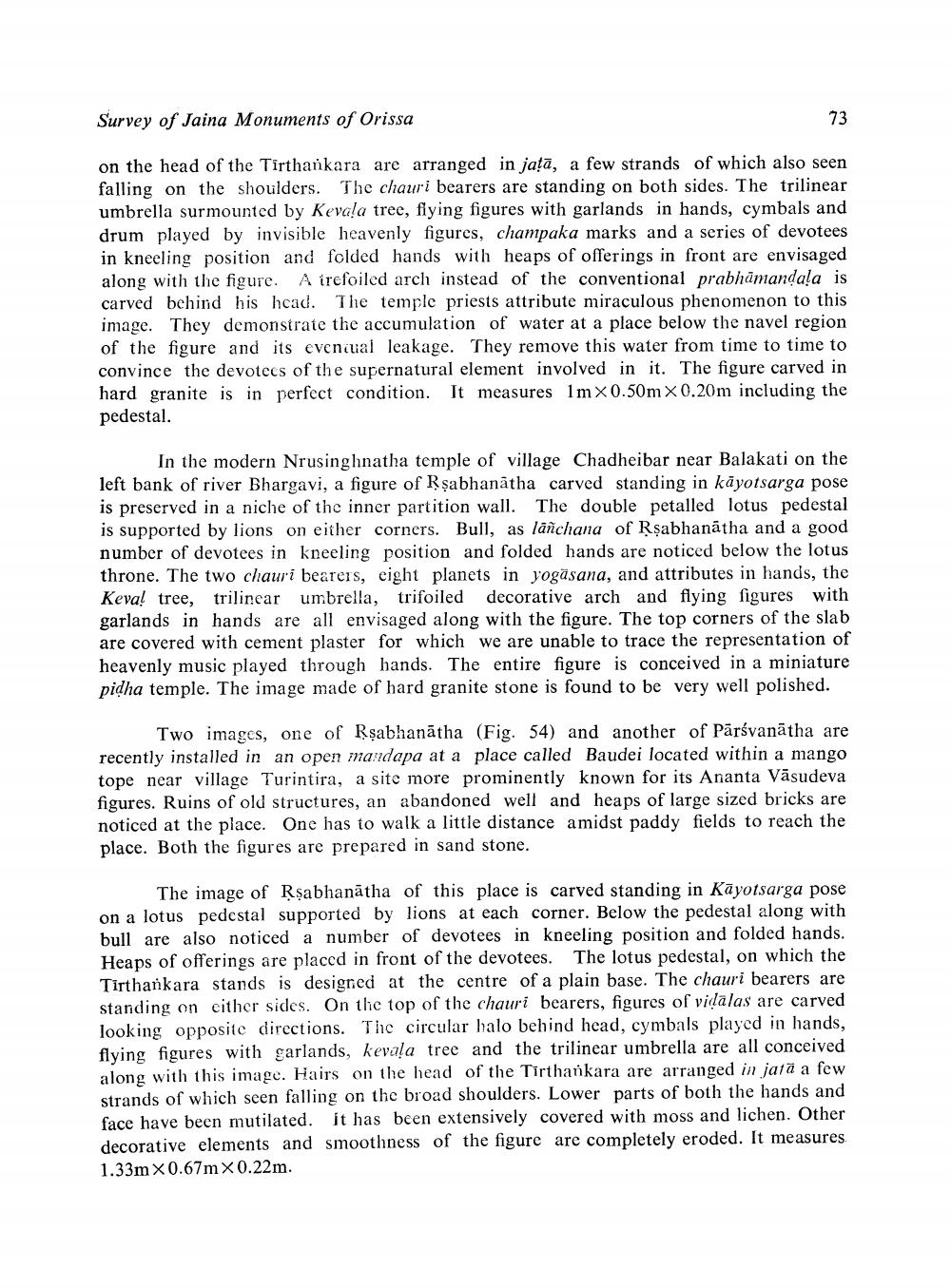________________
Survey of Jaina Monuments of Orissa
73
on the head of the Tirthankara are arranged in jatā, a few strands of which also seen falling on the shoulders. The chauri bearers are standing on both sides. The trilinear umbrella surmounted by Keva!a tree, flying figures with garlands in hands, cymbals and drum played by invisible heavenly figures, champaka marks and a series of devotees in kneeling position and folded hands with heaps of offerings in front are envisaged along with the figure. A irefoiled arch instead of the conventional prabhamandala is carved behind his hcad. The temple priests attribute miraculous phenomenon to this image. They demonstrate the accumulation of water at a place below the navel region of the figure and its eventual leakage. They remove this water from time to time to convince the devotees of the supernatural element involved in it. The figure carved in hard granite is in perfect condition. It measures lm X 0.50m X 0.20m including the pedestal
In the modern Nrusinghnatha temple of village Chadheibar near Balakati on the left bank of river Bhargavi, a figure of Rşabhanātha carved standing in kāyotsarga pose is preserved in a niche of the inner partition wall. The double petalled lotus pedestal is supported by lions on either corners. Bull, as lāñchana of Rşabhanātha and a good number of devotees in kneeling position and folded hands are noticed below the lotus throne. The two chauri bearers, eight planets in yogāsana, and attributes in hands, the Keva! tree, trilinear umbrella, trifoiled decorative arch and flying figures with garlands in hands are all envisaged along with the figure. The top corners of the slab are covered with cement plaster for which we are unable to trace the representation of heavenly music played through hands. The entire figure is conceived in a miniature pidha temple. The image made of hard granite stone is found to be very well polished.
Two images, one of Rşabhanātha (Fig. 54) and another of Pārsvanātha are recently installed in an open mandapa at a place called Baudei located within a mango tope near village Turintira, a site more prominently known for its Ananta Vasudeva figures. Ruins of old structures, an abandoned well and heaps of large sized bricks are noticed at the place. One has to walk a little distance amidst paddy fields to reach the place. Both the figures are prepared in sand stone.
The image of Rşabhanātha of this place is carved standing in Kāyotsarga pose on a lotus pedestal supported by lions at each corner. Below the pedestal along with bull are also noticed a number of devotees in kneeling position and folded hands. Heaps of offerings are placed in front of the devotees. The lotus pedestal, on which the Tirthankara stands is designed at the centre of a plain base. The chauri bearers are standing on either sides. On the top of the chauri bearers, figures of vidalas are carved looking opposite directions. The circular halo behind head, cymbals played in hands, flying figures with garlands, kevala tree and the trilinear umbrella are all conceived along with this image. Hairs on the head of the Tirthankara are arranged in jatä a few strands of which seen falling on the broad shoulders. Lower parts of both the hands and face have been mutilated. It has been extensively covered with moss and lichen. Other decorative elements and smoothness of the figure are completely eroded. It measures 1.33m x 0.67m x 0.22m.




